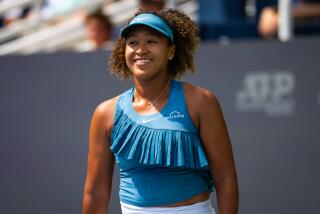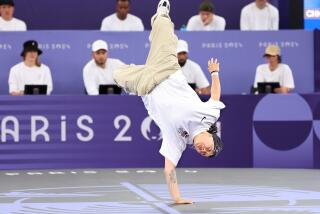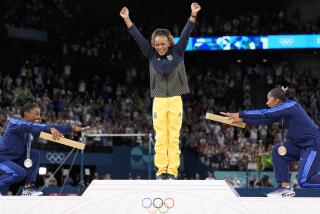At 19, Japan’s Mao Asada already skating on thin ice
- Share via
Reporting from Vancouver, Canada — Less than two months before the 2006 Olympics, Mao Asada of Japan became the first woman to land two triple-axel jumps in the same program.
And Asada wasn’t a two-trick pony then.
She was, at age 15, the best women’s figure skater in the world, winner of the 2006 Grand Prix Final, the one about whom everyone said: “Mao -- Wow!”
But she had to watch the last Olympics on television.
Asada had the bad luck of having been born 87 days too late to meet the International Skating Union’s minimum age requirement - 15 years old by July 1 of the preceding year -- for the Winter Olympics.
As Asada makes her long-anticipated Olympic debut in the women’s short program Tuesday night, the question is whether her time has come -- or gone.
Her recent struggles would suggest the latter. Asada has done so poorly in the short program at her three international competitions this season that her best score (58.96) ranks only 11th in the world, nearly 18 points behind the top score of odds-on favorite Kim Yuna of South Korea.
There are a host of theories for why Asada has gone from world-beater in 2006 -- and world champion in 2008 -- to fourth at worlds in 2009 to an utter also-ran on the Grand Prix circuit in the 2010 season.
One says she is ill-suited temperamentally or artistically to work with Tatiana Tarasova, the Russian coach with whom Asada began to work in June 2008.
Asada was accustomed to long practices full of jumping. Tarasova prefers shorter, less physically demanding practices.
Another theory says Asada has put too much emphasis on the 3 1/2 -revolution triple axel, using it as the first jump -- as part of a combination -- in both the short and long programs. She intends to do two triple axels in the Olympic long program.
That she has failed to land a clean triple axel in any international short program seems to support that idea. If the one big jump fails, programs tend to fall flat, as Asada clearly understands.
“The most important aspect would be to succeed in the short program,” she said at a news conference here. “Of course, the jumps are very important, so when I succeed on jumps, the other elements will have better scores too.”
Asada was a distant third behind Kim in the short program at her first Grand Prix event of the season, sixth in the short at her next Grand Prix event and then third again at the Four Continents Championship in late January.
Even the best of those three performances would probably leave her buried in the much deeper field at the Olympics.
“Short program tends to be my weakness,” Asada said. “I am better at free skating [long program]. I will approach the day before the short program as if it is the day before the free skating.”
Asada’s international free skates have been generally solid this season, although she has struggled with at least one triple axel in each.
Ironically, although she gets props for being the only one among the 30 Olympic competitors planning to attempt the 3 1/2 -revolution triple axel, the jump may not get her enough points to be worth the risk.
For instance, Kim’s planned triple lutz-triple toe loop combination has a base value of 10, while Asada’s triple axel-double toe has a base of 9.7. Kim does a second triple lutz, worth a base of 6.0, compared with the 8.2 of Asada’s second triple axel.
Each skater has chosen the most difficult jumps she feels able to handle. Failure for either would be heavily penalized on the score sheet, and Kim’s big jumps have been more reliable than Asada’s axel.
As was the case in the men’s event, where Evan Lysacek of the United States won the title without a quadruple jump, far more than execution of one element will decide the outcome under the parameters of the sport’s highly complex scoring system.
Japan’s Miki Ando, the 2009 world bronze medalist and 2007 world champion, concedes Kim has a great advantage in a competition that has taken on geo-cultural dimensions because of the centuries-old animosity between Japan and South Korea.
“In the world, Kim Yuna is regarded as the strong favorite,” Ando said, “I believe that she’s a great skater. I think she has something I’m missing in terms of expression and also in the solid jumps.”
And where do the two U.S. skaters, Rachael Flatt and Mirai Nagasu, figure in this?
Flatt, 17, who learned a week ago she had been accepted at Stanford, was fifth in the world last year, and her consistency makes her a threat to capitalize on mistakes by more talented rivals and grab a medal.
She had a nervous practice Monday, failing on the two major jumping passes of her short program run-through.
“Sometimes I try too hard,” she said.
Nagasu appears ready to try anything. She has added a triple lutz-triple toe to her short program.
“She has absolutely nothing to lose,” said Nagasu’s coach, Frank Carroll. “This Olympics is a setup for the next one. She has Olympic champion potential in the way she moves.”
More to Read
Go beyond the scoreboard
Get the latest on L.A.'s teams in the daily Sports Report newsletter.
You may occasionally receive promotional content from the Los Angeles Times.






